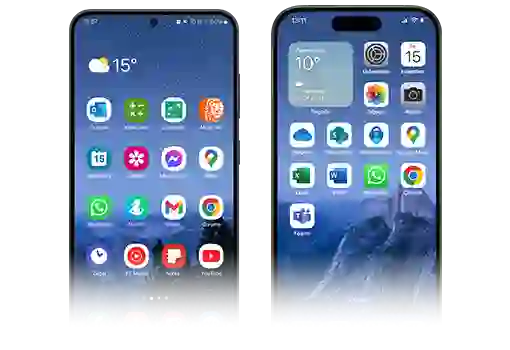Jump to:
What do acronyms related to mobile device management mean?
How to interpret mobility management models?
How to create or choose your device management policy?
Is it possible to meet all expectations?
MDM system – why is it key to implement device management policies?
An effective mobility management policy – a challenge worth taking on
Technology is evolving rapidly, and mobile devices and applications have become standard in business. To keep up with these changes, companies need to find an effective way to manage mobility: control a growing fleet of equipment, ensure business data security, and increase teams’ efficiency.
In this search, every administrator will sooner or later encounter five acronyms – BYOD, CYOD, COPE, COBO, and COSU – denoting different management strategies a company can adopt. We know that the definitions available online often complicate matters. That’s why we explain the whys and hows and why a Mobile Device Management system is essential for implementing each of the strategies discussed.
What do acronyms related to mobile device management mean?
BYOD, CYOD, COPE, COBO, and COSU describe specific policies applied to mobile devices used for work. They are also called the organization’s mobility management models. Their most straightforward division is based on who owns the device.
Thus, we distinguish between policies applied to private devices:
- BYOD – Bring Your Own Device;
and policies applied to company-owned devices (COD):
- CYOD – Choose Your Own Device;
- COPE – Corporate Owned, Personally Enabled;
- COBO – Corporate Owned, Business Only;
- COSU – Corporate Owned, Single Use – limited to a specific business purpose.

How to interpret mobility management models?
As a rule, the equipment owner bears the cost of purchasing and maintaining it. They can also decide which equipment to buy. The exception is the CYOD model, in which the employee chooses the preferred device from a company-defined list.
The ownership of the phone number and SIM card is closely linked to the equipment’s ownership. Accordingly, the equipment owner pays for telecommunications services.
Equally important is the ownership of the data processed on the device, related to the nature of its use. BYOD, CYOD, and COPE models allow simultaneous use of equipment for private and business purposes. However, this raises many concerns about data security, management, and intermingling business and private zones.
| BYOD | CYOD | COPE | COBO | COSU | |
|---|---|---|---|---|---|
| Device owner | employee | company | company | company | company |
| Maintenance | employee | company | company | company | company |
| Phone number owner | employee | company | company | company | company |
| Bill payment | employee | company | company | company | company |
| Data owner | employee + company | employee + company | employee + company | company | company |
| Purpose of use | private + business | private + business | private + business | business | business |
| MDM system required | yes | yes | yes | yes | yes |
How to create or choose your device management policy?
The models mentioned are only a guideline, not a rigid framework to fit into. When creating or selecting a mobility management policy, it makes sense to start with your needs and findings in five key areas:
- Device: who chooses it, who pays for its purchase, who owns it, who is responsible for its maintenance, and who owns the data on it – what kind of use we envision for the device.
- Services: who owns the SIM card number, who pays current telecommunications bills – including roaming resulting from business travel, for example.
- Management and support: who manages the device and who is responsible for technical support.
- Integration and applications: what level of integration with the corporate environment is required to maintain adequate workflow. Any broader integration, beyond basic tools such as mail and instant messaging, requires more work to implement and manage.
- Expectations vs. reality: what department will implement and maintain the created policy, whether the time needed to implement it will fit into the working time of current employees, whether we have the right management tools/systems.

Is it possible to meet all expectations?
In more highly structured organizations, a one-size-fits-all solution is difficult to find. Hence, it makes sense to balance the level of control required and the flexibility of implementing a given policy.
The COBO and COSU models provide the greatest level of control over equipment and data, slightly less by COPE and CYOD, and at the very end by BYOD. In contrast, the BYOD model is the most flexible and fastest to implement because employees already have devices they will be able to use for business operations.
It’s worth remembering that you aren’t limited to one model: different policies may apply depending on the department, device, or area of operations.
Creating specific policies allows you to protect your organization and employees consciously. However, even the best-designed policy will not work without the right tool to enforce the established rules effectively.
MDM system – why is it key to implement device management policies?
To deploy each of the models described in the company, an MDM (Mobile Device Management) solution is necessary. This is software designed for IT administrators, thanks to which they can remotely:
- manage the equipment – configure it, monitor its condition, oversee its life cycle, and impose rules established by the company for the use of the equipment,
- control applications – install and update them, grant them permissions, and remove unauthorized software,
- protect data – implement encryption mechanisms, separate private and business data under separate profiles on a single device, and respond to security incidents (e.g., deleting all sensitive information),
- provide IT support – diagnose and resolve user problems from anywhere.
Check out what Proget system can do for your enterprise.

The MDM system is essential to ensure secure and compliant device management within the models described. It supports the use of the same equipment for personal and professional purposes (BYOD, COPE), allows you to limit the functions of a device to fulfill a single business purpose (COSU, Kiosk) or eliminate the possibility of private use (COBO).
Without MDM, an organization cannot fully meet the objectives of these policies without risking losing control over its own devices, violating corporate security policies, and leaking business data.
An effective mobility management policy – a challenge worth taking on
Managing a company’s mobile devices does not have to be overly complicated or stressful. The key to success lies in a clear identification of needs and a well-thought-out strategy – but technology support is essential for its assumptions to become reality. It is not worth leaving these issues to chance. Investing in a tool such as a Mobile Device Management system will pay off with greater security, regulatory compliance, better organization, and more efficient operation of the entire company.
